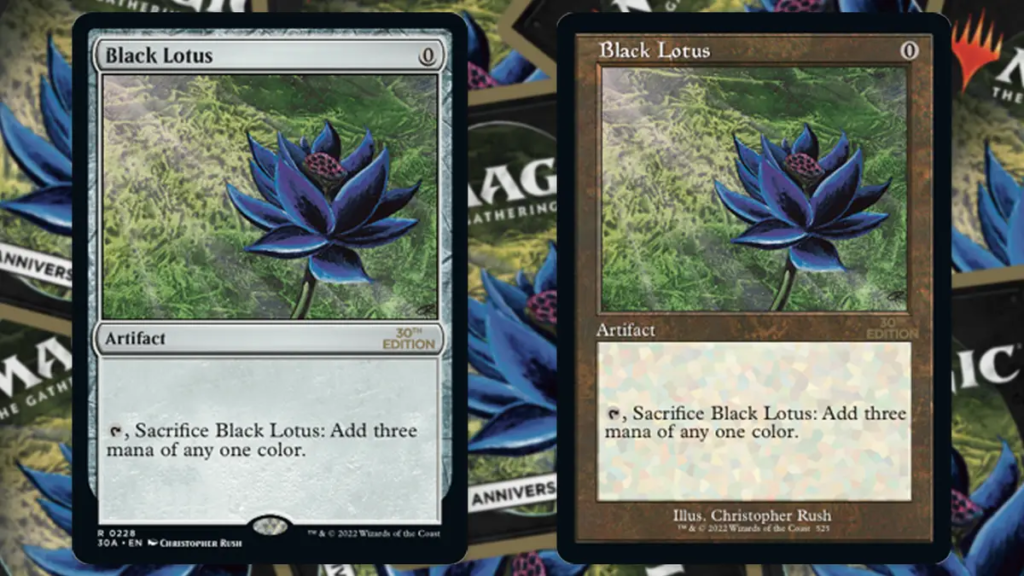The world of collectible card games (CCGs) has witnessed a meteoric rise in recent years, with cards transcending their in-game value and becoming lucrative investments. This trend has culminated in a record-breaking sale that has sent shockwaves through the gaming community – a pristine copy of the legendary Black Lotus from Magic: The Gathering (MTG) has fetched a staggering $3 million. This surpasses the previous record held by The One Ring, a unique card acquired by musician Post Malone for $2 million, and further solidifies Black Lotus’s position as the most valuable game card ever sold.
Black Lotus: A Legacy of Power and Rarity

Black Lotus is more than just a card; it’s a cornerstone of MTG’s history. Debuting in the Alpha set, the game’s very first edition, Black Lotus boasts an unmatched power level. Its ability to generate three mana, the resource used to cast spells, essentially breaks the game’s core mechanics, allowing players to unleash devastating combos early on. This unparalleled power earned Black Lotus a permanent restriction in all but the most legacy formats of MTG, further adding to its mystique and collectability.
However, Black Lotus’s true value lies in its rarity. Unlike most MTG cards printed in common or uncommon sets, Black Lotus was incredibly limited in its initial release. This scarcity, combined with its game-breaking power, cemented its status as the holy grail for MTG collectors for decades. Over time, pristine copies of Black Lotus became even rarer as many were played heavily, leading to wear and tear. This further fueled the card’s value, pushing it into the realm of high-end investments.
The One Ring’s Challenge and Black Lotus’s Resurgence
For a brief period, Black Lotus’s reign as the most expensive card was challenged by the emergence of The One Ring. This unique card, featuring a piece of the actual One Ring prop from the Lord of the Rings film trilogy, was created for a promotional event and subsequently purchased by Post Malone. The sheer uniqueness and celebrity connection temporarily dethroned Black Lotus.

However, the recent $3 million sale of Black Lotus signifies a significant shift. This astronomical price suggests a resurgence of interest in classic MTG cards, particularly those with historical significance and extreme rarity. While the exact reasons behind the sale remain undisclosed, several factors could be at play.
One key factor could be the growing popularity of MTG and other CCGs. As the player base expands, more collectors are entering the market, driving up prices for sought-after cards. Additionally, the rise of online marketplaces has facilitated easier access to these rare collectibles, creating a more global market for high-end MTG cards.
Another factor could be the increasing recognition of CCGs as viable investment opportunities. Traditional investment markets are often volatile, and some collectors are turning to rare game cards as a way to diversify their portfolios. Black Lotus, with its established history and limited availability, is a prime example of such an investment.
A Glimpse into the Future of Gaming Collectibles
The sale of Black Lotus for $3 million represents a significant turning point in the world of gaming collectibles. It not only reinforces the immense value certain in-game items can hold but also signifies the growing maturity of CCGs as a market. This record-breaking sale is likely to have ripple effects throughout the industry, potentially leading to increased interest in collecting rare cards from other popular CCGs as well.

However, concerns remain. The high price tag of Black Lotus may price out new collectors and create a barrier to entry. Additionally, the opaque nature of private sales such as this can make it difficult to accurately gauge the overall market value of other collectible cards.
Looking ahead, it will be interesting to see how the gaming industry reacts to this record-breaking sale. Will stricter regulations be implemented to ensure transparency in card pricing and sales? Will developers explore ways to integrate unique and collectible elements into future games? Ultimately, the sale of Black Lotus serves as a fascinating case study, highlighting the ever-evolving landscape of gaming and the potential for in-game items to become valuable assets in the real world.













